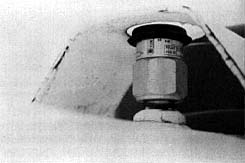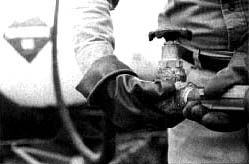When filling a nurse or applicator tank, be thoroughly familiar with the equipment and procedures prior to transfer. Because most accidents occur when transferring ammonia, it is very important to wear goggles and rubber gloves during these procedures. Make sure the five-gallon container is full of clean water and that you have a small squirt bottle in your shirt pocket.
Park the nurse tank on level ground, downwind from the filling operation. Locate the nurse tank close to the source tank to eliminate stretching or bending the hose. Avoid parking too close to obstacles that would make evacuation difficult, such as fences, buildings, or ditches. Block the wagon’s wheels and set the parking brake of the towing vehicle to prevent movement of the nurse tank. A serious situation could develop if the tank moves and a hose tears loose during the filling operation.
Before connecting the hose, make sure the coupling and connections are free from dirt and other foreign material. Visually check to make sure that the threads are not damaged. This will reduce the chance of an ammonia leak under pressure.
Workers should carry the filler hose only by the valve body or coupling, not the valve wheel. This will reduce the chance of the valve wheel opening and spraying ammonia. Remember that the valve wheel and fitting are designed to be closed by hand pressure only. Do not use a wrench to close the valve wheel, since this can easily damage the fitting.
A trailing nurse tank and tool bar are commonly used to apply anhydrous ammonia. Recommended safety precautions must also be used for this equipment. Provide a break-away coupler in the ammonia line that runs to the tool bar. Make sure this coupler is in good working order. This provides protection if the equipment separates accidentally. The valves in the coupler will stop the ammonia gas from escaping in both the upstream and downstream lines. Before reconnecting the coupler, remove the internal pressure from the lines both up and downstream of the coupler. This is done by opening the bleeder valves on each line. Failure to release this pressure could expose you to pressurized ammonia.
Special precautions are necessary when removing dirt from clogged applicator tubes. Because pressure can build up in the tubes if they become clogged, a rush of anhydrous ammonia can be expected when they are unclogged. Wear your goggles, gloves, and a long-sleeved shirt while unclogging tubes. Position yourself upwind from the clogged tube. You can use a long piece of heavy-gauge wire to remove soil and other debris from the tube.

What the tanks look like.

Relife Valve

Using a hose.

Connecting the hose

Bleed Valve

Emergency H2O tank on top of NH3 tank
Even a small blast of anhydrous ammonia can be extremely harmful to the skin, eyes, and mucous membranes in the nose, mouth, and throat. When ammonia contacts the skin or eyes, tissue damage occurs rapidly. This damage results from a combination of dehydration, freezing, and caustic action. If a person’s skin has been exposed to ammonia, move the victim to a safe area, and flush the exposed area immediately with clean water for at least 15 minutes. Remove contaminated clothing as soon as possible. Do not apply salves, creams, or ointments, since these may seal residual ammonia in the skin and contribute to further damage. Contact a doctor immediately after administering emergency first aid treatment.
The subzero temperatures of anhydrous ammonia can freeze exposed skin instantly when sprayed accidentally.
Even if small amounts of ammonia enter the eyes, flush them immediately with water for 15 minutes or more. Hold the eyelids open during irrigation to ensure water contact with all parts of the eye. This can be difficult and painful, but it is an important step to minimize the damage caused by ammonia. Immediate first aid is very important to avoid partial or total loss of vision. Again, consult a doctor after giving emergency first aid.
Ammonia vapors are easily detected because of their pungent odor, allowing them to be detected even in low concentrations. Inhalation of ammonia can irritate the respiratory tract and lungs. At high concentrations, ammonia that combines with moisture in the lungs may damage the lung lining. This can dramatically reduce the lungs’ ability to transfer oxygen to the bloodstream.
If a person has inhaled ammonia, move the victim to a safe area. Exposures to low concentrations of ammonia for a short period of time may not require treatment. Exposure to higher concentrations may cause convulsive coughing and respiratory spasms. Provide cardiopulmonary resuscitation if the victim is not breathing, and summon emergency medical assistance.
If ammonia is swallowed, contact a doctor immediately. If the person is conscious, have him/her drink large amounts of water to dilute the chemical. Never give fluids to or induce vomiting in a victim who is in shock or unconscious. If vomiting occurs, keep the head lower than the hips to prevent vomitus from entering the lungs.
Because of the hazards associated with handling anhydrous ammonia, operator protection must receive top priority at all times. Chemical-proof goggles, rubber gloves, and a heavy-duty long-sleeved shirt are required for anyone handling anhydrous ammonia. In case of exposure, first aid must be administered immediately. Plenty of water for flushing a person who has been accidently exposed to ammonia should be available at all times.
It is important to wear tight-fitting, chemical-proof goggles when handling ammonia. Regular glasses provide virtually no protection. Another option is to wear an approved full-face respirator that combines eye and lung protection. Never wear contact lenses when working with ammonia. Anhydrous ammonia can get under the lens and cause permanent eye damage before the lens can be removed.
Rubber gloves that are impervious to ammonia are required for handling anhydrous. The gloves should have an extended cuff that can be turned down at the elbow to prevent the chemical from running down your sleeve when your arms are raised. Gloves should have a fairly loose fit so they can be removed quickly in an emergency, but should fit tightly enough to provide adequate protection.
You can further protect your arms from ammonia spray by wearing coveralls or a heavy work shirt that covers the arms. Thin dress shirts or short sleeves do not provide protection.
Regulations require that all anhydrous ammonia nurse tanks and applicator tanks carry at least one five-gallon container of clean water. This must be readily available for flushing the eyes and skin in case of exposure. The water should be changed daily to ensure a clean supply. It is also recommended that a second five-gallon container of water be kept on the tractor. This will provide the operator with another source of water for first aid in case the operator is unable to reach the one on the nurse or applicator tank. Handlers of ammonia should also carry an eight-ounce eye wash plastic water bottle at all times in case an accidental exposure occurs.
If you store bulk quantities of anhydrous ammonia, additional protective equipment is required. A rainsuit and two gas masks with currently dated ammonia canisters must be available for emergency work. The protection from a gas mask is limited, and a mask should only be used in low concentrations. If a serious leak occurs, call your local fire department for assistance. Firefighters have the proper training and equipment, including a self-contained breathing apparatus and protective suit, to deal with major leaks.
The operator’s manual for anhydrous ammonia equipment should include instructions on proper procedures to follow when handling the product. Review this information before operating the equipment.
Note all decals on the equipment that identify valves and gauges involved in transferring ammonia. Decals should clearly identify the first aid water and other protective measures.
The filling container:
The specially fabricated and designed equipment for handling the high pressures encountered with anhydrous ammonia should meet the appropriate design guidelines provided by the American National Standards Institute (ANSI). All parts and contact surfaces must withstand a minimum working pressure of 250 psi. This includes such things as pressure welds, safety valves, gauges, fittings, hoses, and metering devices. Any repair or service work on tanks must be done by a firm with an appropriate repair stamp certification. Fitting, valve, and other component repairs must be done by a qualified technician with training and experience in repairing anhydrous ammonia equipment. All welding on anydrous ammonia piping must be done by a welder with appropriate ASME-based welding qualifications.
All containers used for storing ammonia must be painted white or silver. Light colors reflect heat, helping to keep the temperature and pressure inside the tank at an acceptable level during warm weather.
Proper care of the pressure relief valve is an important part of maintenance. This valve is designed to relieve excess pressure from the vapor space of the tank at a predetermined pressure setting. Pressure relief valves must be replaced within five years of their installation date, or if you discover any leakage or other defects during an inspection.
Ammonia hoses are considered the weakest link in the ammonia handling system. Hoses must be checked carefully before each use to make sure they can be safely used. You should replace hoses if you find bulges, cracks, cuts, soft spots, or blisters. Also, replace any hose that has begun to slip near the coupling. Use only hoses designed for anhydrous ammonia. Each hose should be marked with the words “anhydrous ammonia.” In addition, the maximum working pressure, the manufacturer’s name and trademark, and the year of manufacture and expiration date should be stamped on the hose.
Hoses are made with a variety of reinforcement materials and should be replaced accordingly. Hoses reinforced with nylon and stainless steel should be replaced at four and six years respectively, from the date of manufacture, unless defects show up before this time.
Summary:
Anhydrous ammonia is one of the more dangerous chemicals handled by ameture chemists. It can be handled safely when proper procedures are followed. Make sure you wear personal protective equipment and provide plenty of clean water for first aid. Keep equipment in good condition and observe proper procedures when transferring ammonia. When transporting ammonia on the highway, travel at a safe speed. By following recommended procedures you can reduce your chance of having an accident.
Cy
We are the people that your parents warned you about.